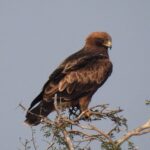The Booted Eagle (Hieraaetus pennatus) is a bird of prey that belongs to the family Accipitridae. It is the smallest eagle species in Europe, but it is a fierce hunter that can stoop down on its prey from great heights similar to a Peregrine Falcon. The Booted Eagle has a wide distribution, breeding in Southern Europe, Eastern Europe, Turkey, and Central Asia, as well as in Southern Africa.
The Global Booted Eagle Population
The global population of the Booted Eagle is estimated to be between 150,000 and 195,000 mature individuals. This estimate is based on the European population, which is estimated to be between 46,600 and 60,500 mature individuals, representing approximately 31% of the global range. The North African population is estimated to be around 20,000 mature individuals.
| Region | Population Estimate (Mature Individuals) |
|---|---|
| Europe | 46,600 – 60,500 |
| North Africa | 20,000 |
| Global | 150,000 – 195,000 |
It’s important to note that these estimates are preliminary and may require further validation to ensure their accuracy.
Habitat and Breeding Preferences
 Image source: Booted eagle By Dr. Raju Kasambe
Image source: Booted eagle By Dr. Raju Kasambe
The Booted Eagle prefers woodland areas without too dense forest growth, but it can also be found in open landscapes such as grassland and semi-arid zones. The species is migratory, spending the winter in Africa south of the Sahara desert.
Booted Eagles build their nests either on a tree or on a cliff ledge, and they often take over old nests of other large birds, including crows, raptors, and herons. On average, 2 eggs are laid, and incubated for 35-40 days before hatching. The chicks stay in the nest for up to 55 days, and the parents continue to feed them for several weeks after they leave the nest.
Diet and Feeding Habits
The Booted Eagle has a diverse diet, with the largest part made up of various bird species, usually representing the most common species in a particular location. When it is present close to human settlements, it often feeds on bird species that thrive close to humans, including pigeons, starlings, and magpies. In addition to birds, it also takes a wide variety of lizards, mammals, and insects.
Conservation Challenges and Threats
The Booted Eagle is currently facing threats from the destruction of its favored habitat, which includes old forests for breeding and more open landscapes for hunting. Public education programs are needed to reduce mortality caused by persecution, and enforcement of laws against illegal hunting and trapping is necessary. Improving facilities for the protection of domestic birds can also help prevent human-animal conflict, and mitigating against deaths caused by powerlines is important.
While the Booted Eagle is not globally threatened and is classified as of “Least Concern” by BirdLife International, many local populations in Europe are small and vulnerable to changes, and should be closely monitored.
Conclusion
The Booted Eagle is a fascinating bird of prey with a wide distribution and diverse diet. Understanding the global population and the specific threats facing this species is crucial for its long-term conservation. By addressing the challenges and implementing effective conservation measures, we can ensure the survival of the Booted Eagle for generations to come.

